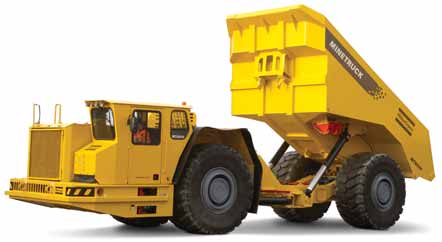
Atlas Copco´s MineTruck MT6020.
Mining: Tools Get Bigger, Faster and Smarter

The Pit Viper 235 is available in both a low-air-pressure rotary drilling configuration as well as a high-pressure hammer version. It is capable of drilling up to 40- ft-deep blastholes in a single pass, in diameters ranging from 6 in. (152 mm) to 9-7/8 in. (250 mm). Look for more details on this model in our upcoming coverage of blasthole drilling technology in December E&MJ.
As described in our 2007 report on Scandinavian mining technology and in our April 2008 issue (See E&MJ, April 2008, p. 59), the MineTruck MT6020 is equipped with the Cummins QSK19- C760 engine, rated 760 hp (567 kW) at 2,100 rpm and delivering 3,084 Nm maximum torque at 1,300 rpm. There is an upbox, drop box and combined Allison M6610 AR transmission/converter that together have improved access to the components. The truck has Kessler 111 axles and the front features a hydropneumatic suspension that improves both vehicle handling and operator ride comfort.
Atlas Copco states the MT6020 can achieve unloaded speeds of 37 km/h on the flat and 27.7 km/h on a 10% grade in sixth gear, and can climb a 20% grade at 15.3 km/h in fourth, assuming 3% rolling resistance. Loaded, the truck should climb a 2% grade at 31 km/h in sixth and a 20% grade at 6.9 km/h in second gear. The MT6020 also has a fast-dumping box design (dumping time is 15 seconds) and large high-spec operator’s compartment.
Atlas Copco also presented the QAS 330 portable generator, rated at 350 KVa of standby power, which the company said was the first of the line’s output rating class to be introduced into the U.S. mine and quarry market. The QAS 330 is powered by a Deere six-cylinder, turbocharged 362-hp (at 1,800 rpm) diesel. Low-noise operation is facilitated by a sound-attenuated steel enclosure, providing a sound level of 73 dB at 23 ft at 75% load.
Bosch Rexroth Pump Promises
Tighter Hydraulic Control
Bosch Rexroth has redesigned its A4VG
high-pressure variable pump for closed
circuit applications. With increased power
density, the new Series 40 helps mobile
equipment manufacturers comply with
stricter worldwide emission regulations.
The nominal pressure of the new series has increased by 700 psi to 6,500 bar and nominal parameters have been adapted to counteract the reduced speed of the diesel engine and therefore lower input flow rates. According to the company, nine nominal parameters make it easy to choose the new axial piston pump with swashplate design for any application. The redesigned pump case provides manufacturers with a variety of ways to include sensors, such as for monitoring swivel angle, high pressure and rotational speed.
Rexroth has completely redesigned the pump case. A new bowl-shaped design avoids high-pressure transitions at sealing points, with some sealing points being eliminated entirely. Rexroth also relocated the high-pressure ports to optimize arrangement of the hydraulic lines. If service is required, the new series uses connections for the O-ring seals to ensure all threads are leak-tight.
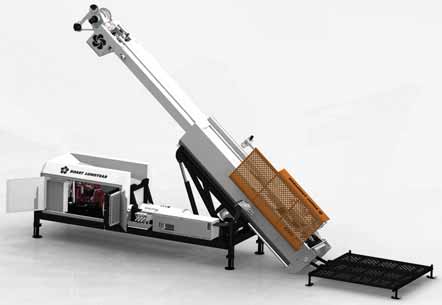
The 4200 features what Boart Longyear claims to be the safest and most flexible rod management system in its class. The “hands-free” rod handling system comprises a rod handler, an autoadjusting breakout tool and hoist plug spinner. The system, according to the company, is capable of handling both 3- m and 6-m rods in sizes ranging from BQ to PQ.
The rod handler provides 270° pickup capability, 2-m height adjustment, 180° rollover and 100° slew. It is equipped with fail-safe jaws and level sensors which limit release positions and eliminate accidental rod drops. Hydraulic accumulators prevent rod slippage if a hose breaks. The system’s wireless remote allows the operator to stand safely away from the machinery.
The 4200 also introduces an openface mast design to this class of drill. This design encloses rotating parts within the mast, such as the drill head and breakout tool, and features guarding at the operator’s level for improved safety. The drill’s two-speed top drive head can be retracted for better clearance when drillers are pulling rods. The breakout tool, according to the company, is openfaced to allow operation anywhere on the drill string and provides sufficient strength to break tight rod joints.
With the launch of the 4200, Boart Longyear also introduced its new drill operating system, featuring Rexroth CANBUS technology. The company said the PC-based operating system reduces fuel consumption and emissions and introduces system intelligence, displaying bit weight and landing indication. The system prevents common mistakes, such as dropping rods down the hole or drilling without water, by alerting operators when defined parameters are not met. The selfmonitoring valves provide real-time status information to operators. An LCD screen leads operators through start-up, drilling and troubleshooting procedures, providing input and directing them to the parts manual and correct part number if a replacement is needed.
Bucyrus Improves Safety
through Technology
Mine operators got a chance to see
Bucyrus International’s entire line of
equipment in one setting for the first
time. The company recently acquired a
major underground mining OEM and now
has most of the bases covered for openpit
mining with draglines, electric shovels
and large blasthole drills; underground
coal/soft rock mining with longwall
equipment, continuous miners and
haulage systems; and bulk material handling
in the form of conveyor drive systems
and hardware.
“The mining industry speaks and we listen,” said Tim Sullivan, president and CEO, Bucyrus International. “They have said that their goal is to get to zero fatalities and our mission is to help them accomplish that goal. You can’t get to zero unless it’s a priority. While reliability is important, it takes a backseat to safety at Bucyrus. We’ve made safety our number one goal.”
The Bucyrus factories and service centers operate at what Sullivan would consider an elevated level of quality for a primarily American equipment manufacturer, but he would like to see them achieve world class standards at every location. “We also want to emulate other successful manufacturers, such as Toyota with its superior production system and Boeing with its advanced approach to engineering,” Sullivan said. “The mandate from the industry is get people out of the way. We will use new technology, such as AC drives, modularity and redundancy, to do our part to help the mining industry get to zero fatalities.”
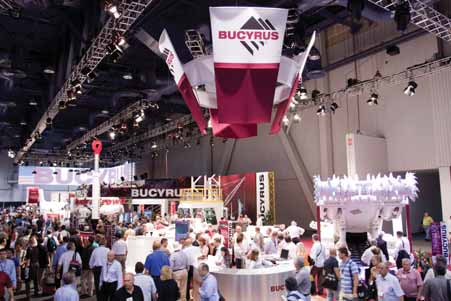
Internally, Bucyrus is still in transition, but all of its offices are now fully integrated and the headquarters for the company is South Milwaukee, Wisconsin, USA. “MINExpo 2008 will be the last time Bucyrus talks about integration,” Sullivan said. “If a company never fully integrates, the outlying operations act as isolated, individual entities. We are one company committed to one set of goals. We are fully integrated.”
The benefits of cross-pollination are already apparent. Bucyrus launched the HydraCrowd system at MINExpo 2008. As opposed to the traditional rope crowding configuration for electric shovels, this system uses hydraulics. “The HydraCrowd is the first major mechanical innovation for the electric shovel in 58 years,” Sullivan said. “Requiring almost zero maintenance, it keeps people off the machine.” The technology is a direct result of hydraulics specialists from the company’s longwall division in Lunen, Germany, talking to the engineers working with shovel crowd systems in Milwaukee.
One of the ways Bucyrus was able to integrate its operations so quickly is by giving a lot of authority to regional managers. “By leaving the experts in place and cross training mid- and front-line managers, all of the divisions have been working effectively as one company,” said Bill Tate, executive vice presidentglobal markets. Tate emphasized that the company’s safety initiative focuses on getting operators out of harm’s way.
Illustrating how the business has grown for Bucyrus, in 2005 they made eight shovels. In 2006, that figure grew to 12 and then it took off—18 in 2007, 24 in 2008, and the company believes it will build 31 shovels in 2009. “We will continue to use existing and well-tested technology to bring innovation to openpit mining,” said Ken Krueger, COO-surface mining. “Considering that a rope change-out would take six to eight weeks, in addition to the safety aspect, we believe the HydraCrowd system could save a mining operation $10 million per year. We have also developed the first gearless AC drive system for a dragline.”
“Innovation is very important to us and our goal is to be the leading underground equipment supplier for coal/soft rock mining,” said Luis de Leon, COOunderground mining. “Automation in room-and-pillar mining could soon become a reality. Underground automation is not to the point where it should be today, but we can make working conditions much safer, especially in the area of machine communications.”
Similar to the management mentality at the mines, Sullivan believes that, no matter how big a company grows, it needs to be run like a small company. “We run lean and local,” Sullivan said. “We can’t afford to lose our edge.”
Caterpillar’s Mining Trucks Hit the F Note
Caterpillar’s new rigid-frame mining
truck lineup now includes both mechanical-
and electric-drive models. The
world’s largest heavy-equipment company
added an AC electric-drive version
(793F AC) to its mechanical-drive 793F
in the 240- to 250-ton class, and introduced
the totally new 795F AC, also
powered by Cat’s proprietary AC drive
system and carrying a 345-ton payload.
Additionally, the top-of-the-line 797B
has been superseded by the new 797F,
which retains its mechanical drive system
and 380- to 400-ton payload rating.
The 795F AC marks Cat’s re-entry into the electric-drive truck sector after a brief foray in the late 1960s when it introduced three DC electric-drive models that carried payloads ranging from 85 tons to 240 tons, but subsequently withdrew them from the market when it decided to focus on mechanical drive technology.
At a MINExpo press briefing, Ed McCord, Cat’s mining truck product manager, presented data illustrating the changing drive-system preferences of mining customers over the past 40 years, starting with a 100% share of the 120- to 400-ton-payload mining truck market claimed by electric-drive models in 1970, shifting to a 56% electric/44% mechanical split by 1990, and more recently swinging to a 61% mechanical/ 39% electric edge by 2007. However, two developments in the 1990s caught the company’s attention: the emergence of a 300- to 360-ton truck class in which Cat had no entry; and advances in technology as modern AC drive systems with solid state controls and brushless motors offered greater drive train efficiency, delivering more rimpull over a higher speed range than DC systems. Cat decided in 2004 that the time was right for development of an electrical-drive truck.
The 795F AC, as the new kid on the block, drew a lot of attention at the show (see sidebar), but Cat also had much to say about its other truck updates, the sum total of which, it claimed, represent a new-generation mindset in its approach to engine, frame and body, cab and overall safety issues—all addressed in its F series models.
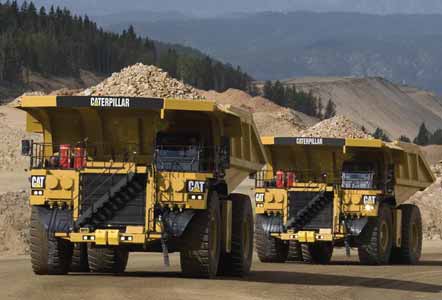
The C-175 will be available in 12-, 16- and 20-cylinder versions rated from 2,100 bhp to 4,000 bhp, with commonrail fuel injection and either single or dual turbocharger stages. The 16-cylinder version will power the 793F and 795F models while the 797F will require the 20-cylinder engine. McCord noted that the C-175 is retrofittable to the 797B series. The 785D, which is the lone D-series model left in Cat’s largemining- truck product line, will continue to be powered by Cat’s 3512C HD engine for the time being, but in all probability will be fitted with the C-175 when the D version is upgraded to F.
According to Cat, its F-series trucks also offer stronger frames, built with mild steel, box section components and both cast and forged pieces for higher durability, flexibility and field-repairable convenience. The updated 793F’s frame, for instance, has changed significantly and now includes larger castings for a new, multi-link four-bar rear suspension similar to the 797’s, allowing more room for serviceability; along with a modified tail casting for higher reliability and longer service life, a lower-stress rear axle housing casting, a redesigned torque tube and improved rear inspection access.
Other updates to the 793F involve a simplified cooling system, integrated steering and hydraulic tanks, and a secondary reduction final drive with segmented bearing, a new transmission with Electronic Clutch Pressure Control, a larger drive shaft now fully enclosed, plus a 10% increase in horsepower provided by a C175-16 diesel over the 793D’s 3516B HD engine.
Upgrades on the 797F include a new retarding option with simplified hydraulics for improved serviceability, intended for applications with high rolling resistance or moderate grades; a more robust Phase 3 differential; increased ROPS ratings to accommodate the weight of customer add-ons; and a redesigned top deck that eliminates the air box for better visibility and serviceability.
The 785D now has standard continuous rear axle filtration. The system circulates axle lubricant through a 6-micron filter to maintain ISO 18/15 cleanliness. According to Cat, cleaner components provide 10% to 20% longer component life, while the system itself reduces kidney loop maintenance times. Also now standard on the 785D is an extended-life disc brake system that Cat claims will result in 33% to 57% fewer discs needing replacement, depending on the application.
Cat has addressed a number of access/egress, noise/vibration and other safety and operator-comfort issues in its new generation of trucks, said McCord, beginning with the inclusion of 600-mmwide walkways and ladders; toe-kick edges on walkways and platforms; and options such as powered access ladders as well as reverse-direction stairways. Service platforms are provided for mechanical transmission, AC alternator, and engine inspection and maintenance. New cab mounts, sound suppression features, laminated glass and seat reduce noise and vibration effects on the operator. Cat has previously offered extra-quiet (XQ) versions, with lower external or “spectator” noise levels, of two truck models—the 785C and 793D—and said it is planning to offer XQ versions of Fseries trucks in the future.
McCord noted that the company has delivered more than 47,000 mechanical construction and mining trucks in the 769-797 series range since 1963 and more than 8,000 large mining trucks in the 785-797 series range since 1984. The first 785 delivered by the company, said McCord, is still working at a phosphate mine in Idaho, USA, and the first 793—which has racked up more than 100,000 operating hours—is running at a copper mine in Arizona.
Also new in Cat’s surface-equipment lineup is the 1,050-hp, 295,000-lb 993K wheel loader which, like the 795F AC truck, marks the company’s entry into a new weight and performance class—in the 993K’s case, between the top-of-theline 994F and the smaller 992K. After determining that potential customers were interested in a mining-class loader with improved structural integrity and digging ability, Cat developed the 16–19 yd3-capacity 993K to meet these demands. For broad comparison, the new loader offers 17% more horsepower, 40% higher operating weight, 16% more breakout force, 27% more rimpull and 40% more static tipping load capacity than a 992G. With the increased weight, Cat claims customers will see a 41% improvement in fore/aft stability which equates to improved hydraulic breakout and lift capacity.
Designed to load Cat’s 100-ton 777 and 150-ton 785 haul trucks in four to six passes, respectively, the 993K offers a fairly high level of parts commonality with its truck and dozer stable mates. For example, its differentials share component commonality with the 777 truck and D9/D11 dozers, and its final drives are derived from the D11 platform but have been tailored for wheel loader duty. Overall, fleet-wide parts commonality includes 22% with the 992G, 35% with the 992K, 32% with the 854K, 22% with the 777F, 19% with the D11T and 10% with the 785C. The new loader also includes tires that are 5 in. wider than the 992Gs, leading to improved lateral stability. Another benefit of the larger tires is better distribution between the rimpull and tire patch area to provide better tire wear rates.
Cat also introduced the AD55B underground articulated haul truck, which replaces the AD55 version. Powered by a Cat C27 diesel—the same unit used in the 775F rigid-body truck— the B version offers a 30% increase in torque over the previous model, a 19% increase in horsepower, 20% more speed (measured on a 14% gradient), and auto-retarding capability. Incorporating numerous performance, operator comfort and maintenance improvements that range from better ride-comfort features to easier, groundlevel access to transmission, engine and fuel filter locations, Cat said the AD55B has provided significant improvements in ton kilometer per hour (tkph) performance, reliability and other operational factors during extended field testing prior to market introduction.
Cummins: Four Million Horsepower
Under the Hood
Engine builder Cummins Inc. didn’t display
any new models at MINExpo 2008,
but focused on reminding the industry of
its considerable market presence and
progress in providing a wide selection of
EPA Tier 2-compliant engines for both
surface and underground applications.
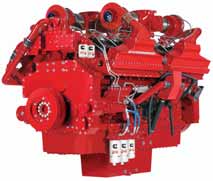
Cummins stated that, after being fitted with its 760-hp QSK19 engines, 60- ton-payload underground haulers demonstrated productivity increases of up to 20%, mainly achieved by higher capacity and faster operating cycle times. Additionally, some of the latest haul trucks as well as LHDs designed for highvolume underground mining are using the 11-liter QSM engine, rated at 290–400 hp. The six-cylinder, 8.9-liter QSL engine has been used successfully to power trucks in the 20-ton-capacity class as well as LHDs in the 10-ton range. Cummins also noted that its sixcylinder 6.7-liter and four-cylinder 4.5 QSB engines were considered a good power match for smaller, low-profile haul trucks and LHDs operating in tight spaces.
The Cummins-powered Dodge Ram still remains the only North America-produced pickup truck with a Mine Safety and Health Administration (MSHA) approved engine—the specially rated, low-emissions 175-hp Cummins Turbo Diesel. Also featured at the Cummins display was the 6CTAA8.3 engine, which the company said has gained increased popularity as a power plant for coal mine transportation locos, carriers and similar equipment. The MSHA-approved 6CTAA8.3 is available with ratings from 185 hp to 285 hp.
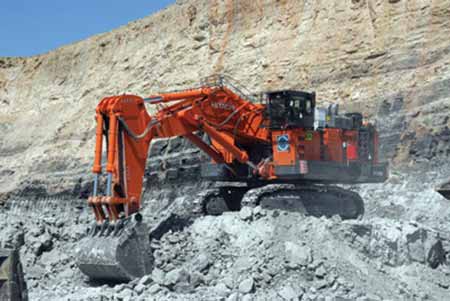
Also standard with the Dash-6 series is the new Hitachi Global e-Service for easy internet access to vital Machine Information Center (MIC) data. This enables owners to use their own computers to check on critical data without having to purchase expensive software or doing manual downloads. Hitachi e- Service makes it possible to remote monitor the health of each Dash-6 excavator. Manual downloads can still be done to obtain all of the MIC data; however, these complete files can be uploaded into e- Service as well.
The Dash-6 line was developed to slash life-cycle costs and reduce downtime by using advanced technology. A highly sophisticated monitoring system provides instant fault and alarm diagnosis displaying warnings and countermeasures if an event arises.
Since Hitachi has been making large mining excavators for so long, it has developed a wealth of data on providing support for its products. Hitachi has also listened to customers and dealers. As a result, the Dash-6 Series “design team” was also focused on determining appropriate warning thresholds and providing more accurate replacement intervals for parts with analysis of the monitoring data.
Hitachi mining hallmarks which continue in the new Dash-6 series include long-life undercarriages, extended service components, field proven structures, and well balanced hydraulic systems providing both productivity and reliability. Hitachi’s exclusive Auto-Level Crowd mechanism on their shovels increases job efficiency with one-lever control.
The EX1900-6 through the EX5500-6 are available in both front shovel and backhoe configurations. The EX8000-6 is currently available as a front shovel only.
Komatsu’s 280-Ton Hauler Offers
Latest AC Technology
Komatsu America Corp.’s new 860E-1K
rigid frame truck is the latest addition to its
line of electric-drive, mining-class haulers.
Slated for limited release in 2009 followed
by full-scale production in 2010, the truck
is designed for a nominal payload of 280 st
(254 mt), and is available with an optional
factory installed trolley-assist system. The
860E is powered by a 2,700 hp, 16-cylinder,
two-stage turbocharged Komatsu
SSDA16V160 diesel that is EPA Tier 2 certified.
According to the company, the 860E
is the first of its trucks to employ a
Komatsu-designed drive system with the
latest Siemens AC power controls, allowing
the 860E to operate with smooth applications
of torque and traction while achieving
a maximum speed of 40 mph (64.5 km/h).
The trolley-assist system, which can be
used on either 1,600- or 1,800-volt lines,
enables the 860E to climb steep grades at
an efficient speed while maintaining low
engine rpm, thus saving fuel and prolonging
engine life.
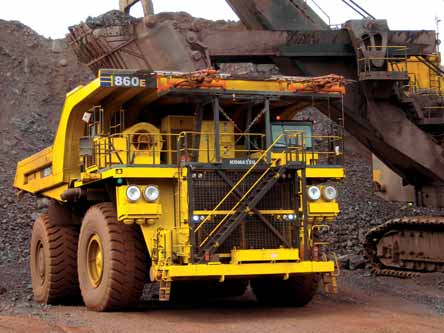
Komatsu said the truck has separate cooling systems for engine and electronics, and has installed standard anti-rollback capability for improved control on steep grades. Hydraulic and electrical line routing also has been improved.
The 860E also offers a larger, isolationmounted, ROP/FOPS certified cab fitted with a five-position adjustable air ride seat as well as a full-size passenger seat. The integrated electronic dash display provides a standard suite of instrument gauges as well as payload data.
When fitted with a standard body, the 860E’s struck load capacity is rated at 160 yd3 (122 m3) and its 2:1 heaped capacity is 221 yd3. Loading height is 20 ft 11 in. (6.37 m).
Earlier this year, Komatsu introduced its largest haul truck, the rigid-body 960E- 1, which stands at more than 24 ft (7.4 m) tall, 51 ft (15.6 m) long and 30 ft (9.2 m) wide, weighs 550,000 lb (250,000 kg) empty and can carry a 360-st (327-mt) payload. Fully loaded, the 3,500-hp (2,610-kW), electric-drive hauler weighs 1,270,000 lb (576,062 kg). Turning radius is 52 ft 6 in. (16 m). Struck capacity for the truck’s standard body is 195 yd3 (149 m3); heaped capacity is 280 yd3 (214 m3); and empty body weight is 90,000 lb (40,823 kg).
Both trucks employ Siemens’ traction drive technology, which was specifically developed for the demands of the mining industry. The new liquid-cooled drive systems have been designed to withstand a higher vibration and altitude spectrum and offer a temperature spectrum from –40° to 60°C.
LeTourneau Offers Hybrid Technology
The centerpiece of LeTourneau Technologies,
Inc.’s (LTI’s) MINExpo display
was the introduction of its latest hybrid
electric drive; which also debuted in their
introduction of the new L-1150 wheel
loader. Introducing what it refers to as
“the next generation drives and controls
for wheel loaders,” the LTI theme
focused on the resulting reduction in fuel
consumption.
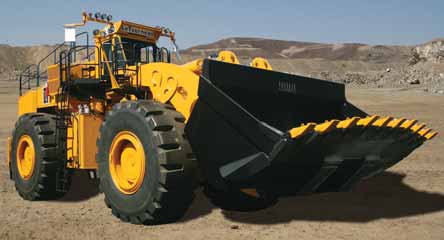
With the existing DC drives, Rogers explained, the diesel engine would drive the AC generator, with the system converting the AC power to DC via silicon-controlled rectifiers (SCRs) to power the DC wheel motors. When the vehicles are required to brake, the traction motors which are then driven, became generators feeding power back to the braking grid to stop the loader. If the braking grids could not handle all of the energy, the excess would drive back through the generator into the engine to cut off fuel. “LTI’s new Switch Reluctance (SR) drives are the most significant jump in technology that we have made in 20 years,” Rogers said.
The SR drive utilizes a DC bus system coming off the SR generator. The initial braking energy goes to a series of capacitors similar to other HEVs. Followed by a significant amount of energy recovered through the drive train (engine rotation, generator rotor, driveline, pump drive gear box, etc.) first overcoming hydraulic loading requirements and then contributing to a tremendous flywheel effect due in part to the constant engine speed. Only a small percentage of energy is lost as heat dissipated through the braking grids.
“In the old days, we could recover about 40% of the braking energy with 60% being wasted to the braking grid,” Rogers said. “With the SR power system we are now converting nearly 90% of energy generated during braking either back to the engine parasitics or to the capacitors. Only 10% is lost to the braking grid. So, at the end of the day, the SR with the modular converter package has moved us further to the forefront of environmentally friendly fuel burning machines.”
The new SR drives use a specially designed water-cooled insulated-gate bipolar transistor (IGBT). Referred to as “cold plate technology” in which coolant circulates through a slightly raised (¼- inch) plate to cool the silicon switches that drive the machine. “The beauty of this technology is that it’s completely scalable,” Rogers said. “For every 300-hp of rotating motor or generator, you need one of those converter packages. You can keep increasing the horsepower of the machine by stacking these packages. And, the packages don’t care if they are on a loader, a truck, a shovel, etc. They will drive any of these SR devices. That will give us a completely interchangeable family of converter devices.”
Aside from the technological breakthrough, the message that hits home is fuel savings. “The fuel savings for L-1150, compared to an equivalent 19 m3 mechanical drive loader, the fuel savings are tremendous,” Rogers said. “At 50,000 hours, the fuel savings amounts to $5 million based on diesel fuel price of $4/gallon ($1.10/liter). Over the life of that machine it will save one-and one-half times the capital cost of that machine in diesel fuel alone.”
The new L-1150 wheel loader is the launch platform for the new SR drives. The 76,000-lb capacity L-1150 has a 25-cu-yd bucket with an 18.6-ft dump height and 9.3 ft reach. Using the next generation LeTourneau Integrated Network Control System (LINCS II), the loader has a 20-secomd time and can be equipped with either a Cummins or MTU-Detroit engine. “The l- 1150 completes our line of large loaders,” said Rogers. “The L-1150 fills the gap between the L-950 and the L-1350.”
The company now has a wheel loader that even pass matches every 50-ton segment for mining class haul trucks. “Ideally, we not only wanted a wheel loader that would 4- to 5-pass load any size haul truck, but more critically be able to center load those trucks to prevent damaged during haulage.”
LTI also introduced a new clamshell bucket design for wheel loaders to handle sticky materials, such as oil sands, similar to a hydraulic shovels. “For years, we have had trouble selling the L-1850 and L-2350 into the oil sands,” Rogers said. “The loader buckets had problems shedding materials into the trucks. This new clamshell design hinges at the top of the bucket as it swings across the truck tray. We pioneered it on an L-1850 at a coal mine in western Canada and target to have a machine on demo in the oil sands next year.”
The LTI B40 motor (425 hp) powers the L-950, L-1150, and L-1350. Also at the MINExpo stand the company displayed a B1XX SR motor (+1,200 hp?). “We don’t have the final tests yet,” Rogers said. “We wanted to prove the larger scalability of the devices and that the converters would fit that device. We have now proven that. What we will do is halve that device to create a B60, which will be the next generation SR motor for the L-1850 and L-2350 available late next year.”
Liebherr Goes the Whole 52 yd3
Comprising more than 100 companies
around the world and with 35 equipment
production sites, the Liebherr Group put a
lot of effort into underlining its status and
significance as a major worldwide supplier of
reliable, productive and safe open-pit mining
equipment.
First and foremost, the Group joined Caterpillar, Komatsu, Terex and Hitachi in the Central Hall, occupying a booth that was spacious enough to display the T 282 B ultra class haul truck, the TI 264 truck and the R 9250 hydraulic excavator. The company also introduced a new flagship excavator model, the R 9800, which is scheduled for test operation in Australia, and the R 9100, a new machine in the 100-t class which should be unveiled within the next year.
Rated at 800 tons service weight and equipped with attachments exceeding 52.4 yd3/40 m3 of loading capacity (at 3,000 lb/yd3/1.8 t/m3), the R 9800 is intended for hard digging and is designed to load 75 tons per pass, so it can work with any truck in the 240-t size class or larger. Both shovel and backhoe versions will be available. Power supply may be from either two Cummins QSK 60 or two MTU 12V4000 engines with output at around 4,000 hp (3,000 kW), able to provide high swing torque and superior digging and breakout forces. In backhoe configuration breakout force is 1,840 kN and digging force 1,750 kN; for the shovel the ratings are 2,980 kN crowd force at ground level and 2,350 kN of breakout force. Electric and pontoon versions of the R 9800 may be introduced at a later point in time.
Both the Liebherr ultra class trucks, the T 282 B and the TI 274, were on display at MINExpo 2008. A company spokesperson noted that the next evolution stage of the T 282 B is under development. The most significant examples of future upgrades involve a new Liebherr IGBT liquid-cooled AC drive system as well as new engine options for increased productivity and environmental compliance. Further, the machine will feature a new electronic control and monitoring system and will be equipped with a new cab.
The model TI 274, making its second public appearance following its introduction at bauma last year, is a revolutionary design. This truck comes with a nominal payload capacity of up to 290 mt (320 st) and an empty vehicle weight of 170 mt (187 st), creating an EVW to payload ratio of 1.71, compared with the 1.33 to 1.39 norms for this size class. Unfortunately from the potential customer’s point of view the truck is not expected to be available until 2010.
Like the TI 274, both the PR 764 hydrostatic crawler tractor and the L 586 hydrostatic wheel loader were first launched at bauma in 2007. These new flagship machines have already achieved some success in the mining market prior to their North American debut.
With a lift capacity of 180,000 lb (82,000 kg), the Super Jack III is a versatile workshop tool with self-propulsion capability. Suitable for most large mining equipment with optional adapters, it is particularly safe due to oversized construction, mechanical locks and hydrostatic brake. So there is no need for safety support stands. The self-propelled wheel handler is an equally versatile workshop tool and provides a lift capacity of 44,000 lb (19,960 kg). It is suitable for a variety of large components with the optionally available adapters, and features motorized component positioning via raise/lower, tilt and rotation of the cradle. Oversized construction and a hydrostatic brake contribute to its safe operation. Both these tools recently have been redesigned to the latest international standards and are produced by JunJin SMC from Korea.
Bernd Haase, executive vice president (sales and marketing) for Liebherr Mining Equipment Co., commented on trends in the truck market. Truck deliveries in the size category above 150 tons payload have increased fourfold since 2003, he noted. However, in the last two years, annual sales of these machines did not rise by more than 10%. For the 360-tonand- over capacity ultra class haul truck category an almost fivefold increase has been recorded since 2003 while 2008 deliveries should be double those in 2006. At the same time emerging markets have started to order large mining trucks for the first time. Unfortunately, the supply of matching sized tires remains critical and Liebherr is committed working with tire manufacturers to ensure our customer’s requirements are met.
So, stagnating overall global demand is accompanied by a continuing trend to upsize machinery and by geographic diversification of delivery destinations. Liebherr expects demand for mining equipment to plateau at a high level.
P&H Unveils New Dragline and In-Pit
Crushing/Conveying System
Among other highlights at its MINExpo
stand, P&H debuted a new ultra-class
walking dragline and an in-pit material
handling concept for overburden at coal
mining operations. Designated the P&H
9030C, with a nominal rated bucket
capacity of 100 m3 (135 yd3), the new
P&H dragline builds upon the 9020s
introduced in 1996. A total of six P&H
9020s have been placed into service in
coal mines in Eastern Australia and
another unit operates in a coal mine in
Canada.
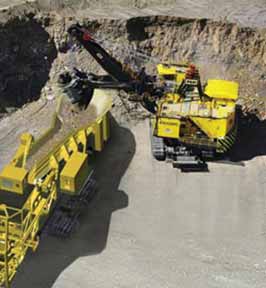
Examples of customer-driven innovations
developed for P&H 9020 draglines
that will be applied and adapted to the
larger-capacity P&H 9030C dragline
include, from the bottom up:
• The P&H Gradial tub, widely recognized
for its structural strength and
ability to distribute the dynamic loads
typically exerted by draglines.
• A spacious, well-lit environment
between the P&H Gradial tub and the
upper revolving frame or machinery
deck made possible by a rugged, largediameter,
high-stack swing rack-andpinion
drive circle that provides easy
maintenance access to the swing and
lube systems in addition to the incoming
power collector ring system.
• A rugged, smooth, highly efficient and
reliable walk system that is not only
propels the dragline, but also sets up
easy for maintenance thanks to its use
of modular planetary transmissions as
well as easy-to-index propel gears that
help increase the useful life of the
modular propel system components.
• A high-ceiling machinery deck set up
for ease of maintenance with highcapacity
overhead bridge crane coverage
positioned directly over motor and
transmission arrays. Hoist and drag
cases are built to withstand the dynamic
forces inherent in dragline operations,
and they are equipped with easyto-
rig hook profiles for smooth, fast
assembly.
• Four-chord-design, wide-flange boom
dig attachment and support structures.
This approach provides excellent
strength to handle the loading dynamics
of the dragline as it moves large volumes.
The A-frames are positioned and
set up to help reduce various loading
factors, thus making possible increased
dig attachment payload and overall
dragline system operating efficiency.
• An advanced dragline operator control
center featuring ample machine-environment
sight lines, comfort- and alertness
enhancing seating and joystick
control ergonomics, and access to the
powerful P&H Centurion control system
that helps optimize the P&H 9030C
operating systems performance while
providing mine maintenance management
with convenient access to
machine system health information for
optimized machine performance and
reduced downtime.
P&H is also developing a 10,000- to 12,000-st/h-capacity In-Pit CrusherConveyor (IPCC) for handling overburden. The company is currently discussing its plans with several coal companies as to how to integrate electric shovels with IPCC systems as a mining system. The rising costs associated with haul trucks in some overburden stripping environments prompted P&H’s engineers to consider this system.
Partnering with JoyGlobal sister companies Stamler and Continental Conveyor, P&H plans to build an IPCC matched to its 4100-class shovels. The heart of the system (on paper) is a shovel undercarriage equipped with DC motors and planetary propel transmissions. Stamler brings several decades of run-of-mine, feeder-breaker and crushing technology to the effort, while Continental brings decades of conveyor systems technology experience.
P&H plans to use its Centurion control system on the IPCC to optimize performance and ease maintenance. The plans also call for the systems to have its maintenance and operation electronically synchronized with electric shovels to which they are paired. Deployment of the first P&H IPCC is planned for 2011.
Sandvik’s AutoMine System Arrives
in North America
Sandvik’s AutoMine automated mining
system isn’t new, having been tested for
years at the company’s test mine in
Tampere, Finland, and installed in several
commercial mines including Inmet’s
Pyhäsalmi base metal mine in Finland,
Codelco’s El Teniente copper mine in
Chile, and at the De Beers-owned Finsch
diamond mine in South Africa. However,
Sandvik used the occasion of MINExpo
2008 to present the first North American
installation of AutoMine, at the Williams
gold mine in Ontario, Canada, jointly
owned by Teck and Barrick Gold.
At the Williams mine, AutoMine controls two Sandvik TH540 haul trucks as they tram gold ore more than half a mile from the hydraulic loader to the crusher. Each truck repeats this process 90 times a day, through shift changes and blasting periods, transporting 600,000 tons of ore a year. A sole operator sits on the surface, behind a desk surrounded by five computer screens and a laptop, intervening only when necessary to avoid potential problems.
The two TH540 trucks at Williams came off the assembly line automationready, including a CANbus electronic control system. To prepare the trucks for AutoMine, Sandvik installed lasers for navigation, video for tele-remote operations and a wireless local area network (WLAN) mobile terminal that serves as the radio communications link.
Sandvik also installed safety gates and infrared beams inside the mine to ensure the trucks stop immediately if they happen to maneuver off the specified tram route or if the secured AutoMine zone is breached. The route itself was created using lasers, an odometer and a gyro that provided the trucks with bearings. According to the company, both trucks follow the path so precisely that they leave only one set of tire tracks.
Sandvik said that since the December 2007 production startup of the system, the mine has reported 96% up time, with just 1% of down time attributable to AutoMine and the other 3% to factors other than equipment performance. Automation has allowed the trucks to operate without incurring damage due to operator error or fatigue, and the onboard computer systems assist with a comprehensive preventative maintenance program, according to Ryan Hawes, AutoMine project engineer for the Williams mine.
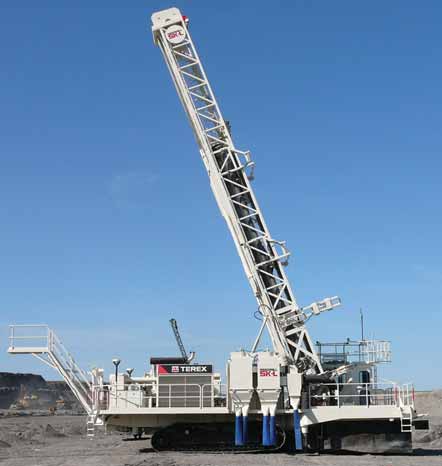
With a design that places a premium
on simplicity, reliability, power and production,
the SK-L blasthole drill lets
Terex Reedrill customers focus on productivity
and profit with these major
features:
• The SK-L’s 20-meter single-pass mast
is designed for strutless 30° angle
drilling and multi-pass hole depths of
up to 65 m. This is achieved through driller and maintenance-friendly rig
design, and a combination of features
such as pulldown and hoist forces,
rotation speed and rotary torque.
• The SK-L’s split cooling system makes
operating in extreme heat easier, while
variable-speed fans and cold weather
packages enable it to easily start-up
and operate with ease in cold weather
and at high altitudes.
• High ground clearance and a low center
of gravity allow it to operate in challenging
conditions. Increased stability
means the SK-L moves from hole to
hole quickly and gives operators the
confidence to move faster than they
might on less stable drills.
• The SK-L’s filters, drain and fill points
plus level gauges and dipsticks are
positioned to speed daily maintenance.
No-slip rear deck, wide catwalks, mast
grid mesh and mast stairs make field
maintenance a snap.
• Its “smart drill” programmable logic
controllers provide computer-aided drill
controls that help lower drilling cycle
times. The operator’s cab also features
a heavy-duty air conditioning system,
and an optional refrigerator, sink and
microwave package.
The company’s new MT6300AC haul
truck offers customers an impressive
array of features and benefits, most
notably its industry-leading payload of
400 tons (363 mt). Additional features
of the MT6300AC include:
• Front-axle ground clearance of 36 in is
ideal for challenging applications.
• Plenty of power. The MTU/Detroit Diesel
C Series 20V4000 engine powering the
MT6300AC offers up 3,750 hp.
• An AC drive system and its reductive
wheel design enables the MT6300AC
to pull away more easily and quickly
from the shovel.
• A larger, longer cab gives operators
more leg room and plenty of storage;
power windows; integral ROPS; curved
windshield and 191° visibility.
• Hybrid, high-efficiency dump body.
Curvature of front, floor and canopy
facilitates easier dumping; life expectancy
of 40,000 hours.
• Improved nosecone design. Makes serviceability
even easier, thanks to axle
box bearing arrangement.
Harry Bussmann, vice president of Terex Mining, said, “The MT6300AC is unparalleled among its competitors thanks to its combination of a unique, from-the-ground-up design and a proven electronics system leveraged from its fellow Unit Rig trucks. Terex Mining is the only one who can say that in this model class.”
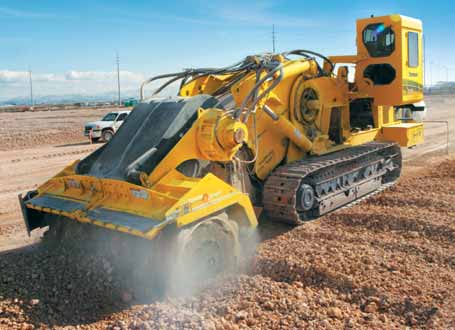
The Terrain Leveler SEM was created when Vermeer engineers swapped out a trencher attachment and added a patented tilt-head milling attachment to the company’s T1255 model tractor. The Terrain Leveler SEM utilizes top-down cutting, a process that allows the cutter teeth to gain penetration without using the machine’s tractive effort to drive the teeth into the minerals.
The process allows operators to control material size by adjusting tooth penetration depths. Increased tooth penetration decreases the material size; while decreasing the depth of penetration makes for a larger material size. This is all done automatically by adjusting the control from within the operator cab. A patented drum tilt system also allows the operator to control grade in both the lateral and longitudinal directions. The unit can dig up to 27 in. deep (68.6 cm) and 12 ft (3.66 m) wide in a single pass.
The machine, according to Vermeer, can handle a wide variety of materials. In Western Australian iron ore operations, production rates have ranged from 150 to 450 bank cubic meters per hour, averaging about 250 bm3/h. In South African coal, the machines can produce 600–900 m3/h, and in tests at a U.S. copper operation, an SEM achieved a rate of 1,100 t/h, producing a 16-in. product. The company reported that three of the units will soon be operating at a copper mine in the Democratic Republic of Congo.
Precision surface mining will also incorporate high-technology communication in the future by using Global Positioning System (GPS) technology and two-way data communication. An engineer could create a mine plan in the office and send the data to the on-board computer of the Terrain Leveler SEM. The operator can then pull up the plan on the screen and tackle the various layers of material based on the new plan. The SEM can also be set up for laser guidance. For mining applications, Vermeer conducts what it calls a “Rock Lab” test, analyzing core samples to assess the compressive strength, abrasive properties and other characteristics of the material, allowing them to select the right style of cutting tooth to be mounted on the drum.